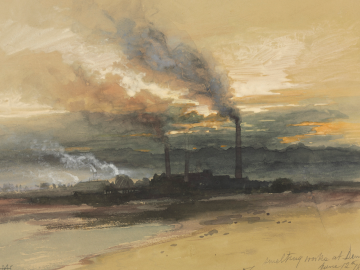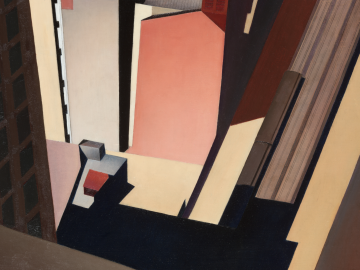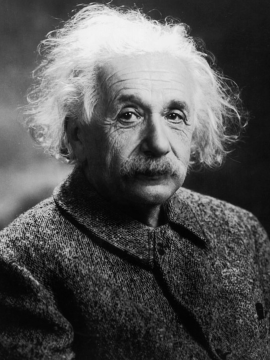Matters of the Heart
Meryl Broughton
He lay there naked under the strong artificial lights, his damp skin cool to touch. He would tell me what happened but not through words. It was still dark outside at the time we met in the basement room of the old regional hospital. We were not alone.
I checked him over from top to toe, carefully and clinically. There was no grey in his hair, no unusual features on his torso or limbs, no sinister marks, nothing suspicious. I looked directly into his eyes, but he could not see me. He could not see anything, nor could he hear.
My companion approached from the periphery and took up a scalpel blade. While I turned my attention elsewhere, this third member of our trio made a sweeping incision on the recumbent form from Adams apple to pubic bone. The bare man did not flinch.
In essence, he wasn't really there at all, he had already moved on to wherever people go when they have finished with their mortal bodies.
He had died, suddenly and unexpectedly, two days earlier. He was only 47. The Mortuary Admission form forlornly recorded his collapse at home in the shower, the failure of cardiopulmonary resuscitation attempts, his death from an apparently natural cause.
What could possibly be “natural” about this? The average life expectancy for an Australian male in this era is 80 years. In forensic terms though, unnatural refers to a death caused by an accident, purposeful injury or criminal activity.
We have generally been protected from the ravages of environmental catastrophes and contagion by public infrastructure supplying clean water, sanitary waste disposal, adequate food and secure shelter. Instead of acute disasters, we are now more commonly afflicted with the chronic conditions of cancer and cardiovascular disease. These things take time to develop but can still kill us suddenly without warning. Is that really without warning, or just that we don't pay attention?
Now this relatively young man was dead, he no longer required anything to eat or drink, nor even air to breathe. But he did need a death certificate; or rather, those left behind needed one. Such a document provides information for vital records, personal and public. A key element of the certification is the cause of death. Why did he die?
This was the main purpose for us being in the autopsy suite. His case had been referred to the local coroner, who authorised a post mortem examination to determine the reason for his untimely demise. I was the general practitioner tasked with his final medical encounter. Even this situation was somewhat extraordinary.
A coronial autopsy is usually conducted by a forensic pathologist. Indeed, I was the only generalist doctor in the state performing post mortem examinations for the coroner at that time. In rural and regional areas of Australia, many general practitioners have training in specialist fields to provide services that would otherwise be unavailable to country people. Without these, they have to travel to the city hundreds of kilometres away.
Practitioners with adequate skills in anatomical pathology, however, are becoming harder to find. Medical students and trainee doctors have minimal exposure to post mortem examinations these days due to the decline in routine hospital autopsies. There are insufficient opportunities to acquire functional capacity because of competing interests, and the structure of post-graduate training no longer readily allows transfer across specialties.
But here we were then, the three of us, engaging in an activity that was heading for extinction. At least on this occasion we could get a timely answer to the question at hand that would solve a distressing mystery for all concerned. “What was the cause of death?”
Making the extensive incision to give access to what lay within was just the beginning. We carefully separated the skin from the ribcage it covered, and opened into the peritoneal cavity of his abdomen. The skin flaps laid to each side were like curtains in a theatre parting to display the stage set behind. A yellow lacy apron of omentum lay discretely over his intestines.
My assistant wielding the plaster saw interrupted this restful state. He cut the ribs on each side of the body in line with the front of the armpits. A little more soft tissue dissection enabled him to lift off the front part of the ribcage like removing a shield. Injuries were revealed: his sternum was broken and several ribs on each side. This had happened during the resuscitation process.
We then pause for the most aesthetically pleasing moment of the post mortem examination: viewing the internal organs settled in their normal places. Seeing things the way they really are inside a real human makes an impression on the viewer. This is an all too rare experience for contemporary health professionals. I never tired of it in over four hundred autopsies. And when examining living patients in the course of my routine clinical duties, I can more readily picture what is underneath my palpating hands.
Back to work after inspection and introspection. I notice the membrane around his heart is abnormally stretched up by fluid. It is not meant to be like this. The pericardial membrane is usually closely applied to the heart it protects. Delicately lifting a portion of it with forceps in my left hand, I make a small cut in the pericardium with curved scissors in my right hand.
Into this hole I insert an empty syringe and draw the plunger back. It fills with light brown fluid. There is a lot of it. I swap my syringe for a surgical sucker. 350mL of serous liquid comes out before the sucker blocks. I open the pericardium further and scoop out 450g of clotted blood with my gloved hand. When blood has spilled out of the vascular system it separates into its components, the watery part on top and solid parts underneath, responding to gravity.
Blood in the sac around the heart is a haemopericardium. The heart is still pumping when this catastrophe occurs, and as the blood accumulates in the confines of the pericardial sac, it starts to squeeze on the heart itself, impeding its function until it stops beating. This is called ‘cardiac tamponade’. If there were some way to reduce the pressure, the heart and its owner could be saved, but the cause of the bleeding would simultaneously need to be treatable.
So there it is; the proximate cause of this man's death was haemopericardium. But we haven't finished yet. We have to find where the blood came from, and why, to determine the ultimate cause of death. We have to go on.
We take samples of blood, urine, bile and later, liver tissue, for toxicology. This is part of the forensic routine. It is appropriate to have these in storage for analysis later if needed.
My autopsy technician cuts the blood vessels that link from the chest to the upper limbs and neck. He tips the man's chin up and, through the opened skin, incises the floor of his mouth. Pulling the tongue through the bottom of the jaw towards the feet, the organs of the thorax come forwards and out. He cuts through the lower end of the gullet and the thoracic aorta, releasing the block of innards into the waiting tray. The technician, as you may have gathered, does all the gruesome chores of the autopsy while I, the doctor, get to do all the intricate elements of discovery.
He continues working to remove internal abdominal and pelvic organs while I begin my examination of those already extracted from the man's chest. These parts are still all connected to each other as they lie on a large thin sponge in the intense illumination of my dissection bench.
I orientate the thoracic organ block with the throat closest to me and the bottom of the lungs away at the wall. It is as though, with chin on my chest, I am looking down on my own organs and in a way, I am. “Autopsy” literally means “self look”. Although usually interpreted “to see for oneself”, it could equally be translated to look at yourself. The correct term for the post mortem examination is “necropsy”, to look at the dead. Like most people, I prefer the other term.
This man was born a year after me. The cause of his death is relevant to many of us. You see, one purpose in establishing why he died is for public health reasons. It will add to information gathered from other sources to direct funding in research and therapy. Perhaps we can prevent tragedies like this from happening to more of us.
Using my Metzenbaum scissors again, I cut from the transected ends of the neck arteries into the ascending aorta, the main artery that carried oxygenated life-blood from his heart to the rest of his body. A tear in the aorta can rupture back into the pericardium. This caused haemopericardium in some of the other cases I was involved with, but not him. His aorta is the pristine elastic tube it was meant to be.
His heart lays within the opened pericardium. As I lift the far tip of his heart towards me, I see a gash in the back of the left ventricle, the main cardiac chamber that pumps into the aorta. Only, in him it had pumped blood out of the hole into the pericardial sac and killed him. So the cause of his haemopericardium was a ruptured left ventricle. But we haven't finished yet. Why did his heart burst? We have to go on.
I cut the various major blood vessels where they enter and exit the heart itself. Released from its bonds with the rest of the structures from the chest, I gently open the top two cardiac chambers, the atria. They are empty. Next, I weigh his heart. It is heavier than a normal heart should be for his age and size, but clearly his heart was not normal. Most of the people I examined for the coroner had enlarged hearts.
How do I feel when I hold a person's heart in my hands? I've only ever done this when they have finished using it, when it is quiet and still. I expect the experience is different for those doctors who handle active hearts.
Despite knowing that the seat of emotion resides in the brain, we instinctively associate the ethereal elements of living creatures with their heart. The essence of life seems to be there; the heart represents the core of existence. This impression can interfere with accepting brain death as definitive. It makes deciding to donate organs from a “beating-heart cadaver” an emotional challenge.
We often have mixed feelings about mortal remains. They take on a particular significance that is hard to explain. Why do we feel reluctant to disturb the deceased, even though we acknowledge intellectually that no further harm can actually be experienced by them? Performing a post mortem examination can be perceived as a further invasion of physical integrity.
But at times we are coerced by legal requirements. Here, we are on the sanctioned quest to find the reason for a man's sudden death. As yet we have only half the answer. We press on.
Using a thin sharp double-edged blade, I cross-section the heart. I make narrow slices and lay them out on the dissection sponge for close inspection. The blood has poured through an area of defective heart muscle that is soft and mushy. It is not meant to be like that. This section of the myocardium has necrosed. There's that ugly word again: ‘necrosis’ means tissue death. The death of this tissue led to the death of the whole person. It is a myocardial infarction, heart attack.
Now we are closer to the underlying cause, but we haven't finished yet. We have to go further. I place my left thumb inside the root of the transected aorta, stabilising my hold on the heart. I meticulously incise the coronary arteries every 3mm as they circle around the outside surface of the heart like a crown. That is what “corona” means, why they are called coronary arteries.
There. The right coronary artery is blocked by a thrombus, a clot. Despite the apparent redundancy of blood supply to the heart, this single vessel occlusion was significant, rendering the rest unable to compensate. The blockage is in the setting of atherosclerosis affecting all his coronary arteries, more or less.
Over time, cholesterol has accumulated in the artery walls in a lumpy sort of way. That is the atheroma part. The body tries to deal with it by forming scar tissue. That is the sclerosis part, hardening the arteries and making them narrower. Intravascular pressure contributes to blood vessel stiffness in a linear fashion. Then small areas of the lining roughen up instead of being smooth. That allows platelets to stick on, trying to repair the damage. That sets off the clotting process and subsequent doom.
Sometimes there are warning signs that the coronaries are inadequate. A tight sort of sensation in the front of your chest on exertion as the heart muscle cries out for greater blood flow, but the hardened narrow arteries can't fully respond. This feeling might not be that bad and quickly eases as you back off the physical intensity. The sensation might not be in the usual place. It could be in your back, your jaw, your left arm.
Or there might be no signals until the artery blocks, which can occur at any time regardless of activity. Then the heavy feeling stays and doesn't ease off. It still may not feel that bad but it is hard not to think of anything else while it is there sitting on your chest like an elephant. But even a blockage might not give symptoms.
There was no report of such experiences for this man, as is often the case in sudden unexpected death. It takes about 3 days for the bit of muscle deprived of its blood supply to die off and get to the critical soft stage when the force of the ventricle contracting could push blood right out through this damaged part. The heart attack thus occurs several days before a rupture may happen. But most myocardial infarctions do not result in this dramatic event.
Now we have the complete sequence as it would appear on his death certificate.
Cause of Death: Haemopericardium due to Left Ventricular Rupture due to Myocardial Infarction due to Right Coronary Artery Thrombosis due to Coronary Atherosclerosis.
We don't think about death most of the time. We live as though there will always be a tomorrow for us and our loved ones. Even if we are prepared, death always causes us emotional pain. Somehow we feel it in our heart and not our brain.
We know what the risk factors for heart disease are: increasing age, being male, smoking, type 2 diabetes, high blood pressure, high cholesterol, family history, obesity, physical inactivity, chronic inflammatory diseases, being an Aboriginal or Torres Strait Islander. The more risk factors you have, the greater the absolute risk. Some factors can be modified, some can't be.
So what are we going to do to stop more hearts from breaking?
Feature image via 'Art Collection - The Metropolitan Museum of Art'


